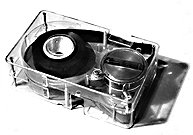
Apparently the design aim was to produce a system with
a tape the same size as the Sony company diary...
| The Japanese "consumer electronics" companies must have watched the limited but undeniable success of
the Philips VCR formats with naked hunger, aware of the huge potential that a successful home video system would have
throughout the world. Several Japanese companies were developing systems during the early seventies, but it was Sony
and JVC who were to become the key players.
Sony's professional and industrial U-Matic format, released in 1971 in Japan and the US and in 1973 in Europe, came to dominate the training, demonstration and closed-circuit TV markets, and was even used for broadcast ENG (electronic news gathering) in some areas. It had never made an impact in the home market, due to its size, expense and technical complexity, but knowing that the fundamental technology was right Sony set about adapting the system for home use. |
 |
A prototype Betamax cassette
Apparently the design aim was to produce a system with a tape the same size as the Sony company diary... |
| In 1974 they demonstrated a prototype home version to the other major players, JVC and Matsushita, who were known to be developing their own systems at the time. The intention was to persuade these other companies to fall in behind Sony and back the new system, avoiding a format war; perhaps not surprisingly the others preferred their own systems. The one-hour maximum running time of the Sony format, as for U-Matic, was a particular sticking point. | |
| Undeterred, Sony pressed ahead with the format and on April 16 1975 the Betamax format was announced to the
world - or at least to Japan. Betamax was in many ways the same as U-Matic, scaled down from 3/4 inch tape to 1/2 inch.
The first ever Betamax machine was the SL-6300, which was built into a TV. The stand-alone SL-7200, which looked very similar to the U-Matic machines it was derived from, came out the year after. |
 |
| These machines were hugely expensive; the 6300 cost $2295, which must be the equivalent of something like $12,000 (£6000) today; the 7200 cost around $1300. A Betamax tape cost about $15 - perhaps £45 in today's money. | |
 |
The initial one-hour version of Beta was quickly superceded by a slower running version, Beta II, also giving
two hours. All US and Japanese Beta machines sold used this slower system; an additional extended-play mode, Beta III,
was added later which gave even longer running times at the cost of slightly poorer picture quality.
The SL-7200 |
| Betamax reached the UK in 1978. Despite its high quality, it was eventually defeated in the Format War,
and in 1988 Sony began manufacturing VHS machines. This is covered in more detail in the
Format War exhibit. Incidentally, the name Betamax is derived from a Japanese word "Beta", which apparently means quality (and can also describe the recording system) plus "Max" to imply maximum quality. There is some confusion about the exact name, however; All Sanyo machines use Betacord, the camcorder format (see room 9) was called BetaMovie, and the later derivatives were SuperBeta, Beta HiFi and BetaCam. So, some people consider that "Beta" alone is the name of the format. I tend to use "Betamax", because that's what most people remember. | |